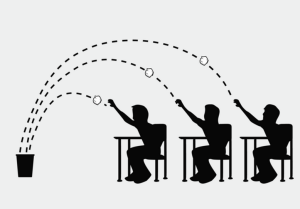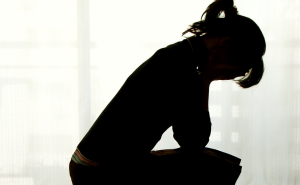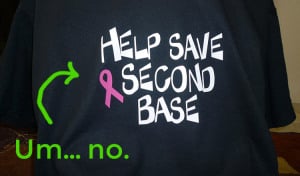Like most people, the messages I got about sex growing up came from a variety of places.
They came from my parents, of course, who, while liberal enough on the matter, could still say things like “It just isn’t seemly for you to have a boy alone in your room,” and who somewhat sadly explained that it simply wasn’t as safe for me to walk home alone at night as it was for my younger brothers to do so.
Then there were the fashion magazines I devoured. These regularly reinforced the idea that if a woman could just master this or that one sex trick, then she could persuade her man not to stray (something we couldn’t really blame the fellas for, because—well—insatiable sex drive and all).
And there were a thousand messages coming from movies and sitcoms where the fat, slobby dad/hot, skinny mom trope was a constant, rape and sexual harassment were framed as a guy simply being persistent about getting the girl, and where an incredibly traditional cishetero standard around sex and dating were sold as not only the norm, but also as the expectation.
But it was at school that these messages were really driven home.
School was where I learned that girls increased their social standing by appealing to certain boys. It was where it became clear that it was desirable to be considered sexually adventurous, but that this adventurousness should never cross some hard-to-define line that made you seem too sexually available.
And it was the place where it was driven home that while boys could freely joke about masturbating and getting off, a girl who even hinted at this was somehow nasty.
I’ve spent a long time since high school criticizing these messages. And these days, I teach in a high school where I try to challenge today’s version of them.
But being in a school environment as an adult is a constant reminder that while an awful lot has changed for the better since I was a teenager, a lot of modern teens still have to deal with some pretty old-fashioned ideas about sexuality at school.
That’s where you come in.
As parents, you have the power to challenge harmful messages and deflate some of their power.
Of course, before you can begin to do so, it would be helpful to know what some of them are.
So here are a few of the most common.
Myth #1: Sexual Harassment and Violence Aren’t Crimes – They’re Just a Part of Everyday Life
Though a huge number of teens face sexual violence, far too few are calling this what it is.
In a study published in Gender & Society, Marquette University sociologist Heather Hlavka reported that a significant number of teens view objectification, sexual harassment, and abuse as everyday experiences that they just need to put up with.
Hlavka found that girls avoid reporting harassment or violence because they fear backlash from peers and worry about getting labeled “whores” or “sluts.”
Additionally, she discovered that many girls don’t want to make a “big deal” about what happened.
So what’s behind this?
There are a lot of factors, but a notable one is the view that victims are responsible for preventing rape and sexual harassment.
This is reinforced both by other students, as well as by school administrators, and by school-sanctioned programs that often advise girls about multiple ways to prevent rape (don’t drink too much, stay with your friends, keep to well-lit areas, don’t dress sexy, or send “mixed” messages), but don’t address issues like consent, communication, and rape culture.
The result is that victims can be reluctant to label what they experience as sexual violence since their stories are often doubted and they’re held responsible for what happens to them.
Myth #2: Dress Codes Are Needed – Otherwise, Girls Will Dress Suggestively and Boys Won’t Be Able to Concentrate
If you Google “dress codes” and “distracting,” you get pages of results documenting how dress codes are justified with the claim that girls’ clothes have to be policed so that boys can concentrate on their studies and not on the legs or shoulders of the alluring creatures next to them.
A lot of this is based on the idea that boys can’t control themselves sexually and are at the mercy of their sex drives.
From the oft-repeated (but utterly baseless) claim that teenage guys think about sex every seven seconds, to the warning that girls get to never be alone with boys, the idea that boys are at the mercy of their raging hormones (and that it’s girls’ jobs to keep them in check) is driven home at every turn.
Not only is this notion heterosexist and offensive to boys, but it continues the problematic tradition of putting the responsibility for male sexuality onto women.
These issues are not lost on students who, across the country, have protested sexist and homophobic dress codes that are justified by such beliefs.
For example, this fall, a high school student named Reese Fischer was upset that her school adopted a new dress code policy requiring students – almost exclusively girls – to leave class and sit in the principal’s office until their dress code violation was addressed.
In response, she started a petition called Not a Distraction and helped organize a protest where students wore scarlet letter A’s to school.
Still, despite some media attention, the dress code at Renee’s school, like that at many others, remains unchanged, and girls continue to dress every morning – not with an eye to clothes that make them feel good, but rather with a ridiculous amount of attention devoted to hiding the fact that they have female bodies.
Myth #3: For a Girl, Being Sexually Open Often Just Means Being Appealing to Boys
Our understanding of female sexuality has advanced significantly from the Victorian era when women were assumed not to have sexual desires.
But we still haven’t gotten to a place of equality about our expectations for a hetero encounter where sexist and gendered ideas about sex can still loom large.
For example, in a New York magazine article on the imbalances inherent in many man-woman hooks-ups on college campuses, Rebecca Traister writes,
“Male climax remains the accepted finish of hetero encounters; a woman’s orgasm is still the elusive, optional bonus round. Then there are the double standards that continue to redound negatively to women: A woman in pursuit is loose or hard up; a man in pursuit is healthy and horny. A woman who says no is a prude or a cock tease; a man who says no is rejecting the woman in question. And now these sexual judgments cut in two directions: Young women feel that they are being judged either for having too much sex, or for not having enough, or enough good, sex.”
And I would hazard a guess that if this is the climate around sex between college students, that goes double for those in high school.
Sadly, in 2015, far too many people continue to measure a girl’s worth by how sexy she seems, which is then measured by how much she is desired by guys, and how much she will “let” those guys do with her.
Myth #4: Cis-Hetero Standards Are the Expectation
Despite advances on gender and sexual orientation, for a lot of kids, schools continue to reinforce a cis-hetero expectation.
One of the ways this occurs is through the idea that for girls, being popular is directly linked to their status with boys.
As Elizabethe C. Payne, the Director of the Queering Education Research Institute writes,
“One study reported that when teen girls were asked what characteristic was least likely for a popular girl, they said: ‘lesbian.’ In their estimation, popularity required attracting boys, and the activity of attracting boys required a lot of effort around which girls could bond and compete, forming relationships and positioning themselves in the social hierarchy.”
The climate isn’t better for gay boys, or for trans or gender nonconforming kids, or really, for any kid who finds themselves outside of the cis-hetero confines, since in a lot of places, there is one standard measure for social acceptance that is applied to all students.
Additionally, many schools still teach abstinence-only education, which if it covers gender identity or sexual orientation at all, only does so in negative terms.
As the ACLU reports, most abstinence-only curricula exclusively address LGBTQIA+ issues within the context of promiscuity and disease. Students are often taught that homosexuality is “unnatural.”
Several curricula are overtly hostile to queer and trans folks, and in 2015, state laws surrounding sex education can still be explicitly homo- and transphobic.
For example, kids in a South Carolina school recently came home with a letter about an upcoming sex education unit that included this statement: “The program of instruction for this unit may not include discussion of alternate sexual lifestyles from heterosexual relationships including, but not limited to, homosexual relationships except in the context of instruction concerning sexually transmitted infections.”
So while we have more GSAs, LGBTQIA-friendly YA, and support services than ever before, for a lot of queer kids, the message remains that they are somehow deviating from the expected norm and will be forced to remain on the fringes of school life as a result.
How Parents Can Counter These Messages
The messages kids get about sex at school often equate it with a lot of other negative things like substance use, truancy, and violence.
Combined with enduring sexist and homophobic notions, sex itself is often presented as something inherently dangerous or dirty.
So here are some ideas for parents who want to challenge what their kids may be hearing about sex at school:
1. Oppose Abstinence-Only Education (And Support Comprehensive Sex Education)
The latter covers a range of issues related to sexuality and discusses sexual orientation and gender identity.
Make a meeting with the school principal and go to school board meetings, write letters to the editor, and get support from other parents!
2. Start Talking About Consent at Home
Don’t fall into the trap of victim blaming, and support your children if they tell you about harassment or violence.
As Michelle Dominique Burk writes on this site,
“It is important to begin talking having these discussions with kids when they’re young so that the decisions that they make as they proceed through adolescence and adulthood are informed by their understanding of what it means to give and receive consent.”
3. Challenge Sexist and Homophobic Comments When They Come Up
Support LGBTQIA-inclusive initiatives. And remind your children that you don’t have cis-hetro expectations for them.
4. Give Support, Not Shame, To Sexually Active Teens
If your child is sexually active, allow them to come to you with questions, give them safe private space to have sex, and reinforce the idea that sex should be pleasurable for everyone.
5. Understand That There Is No Way to Avoid the Power of Media
It has a lot influence in shaping cultural views.
As filmmaker Jennifer Siebel Newsom, Founder of The Representation Project, says, “Parents need to talk with [all of their children, regardless of gender] about the stereotypes they see in media, discussing what’s wrong with the stereotypes and what they can do to counteract them.”
***
Teens are inundated with negative messages about sex at school.
Sometimes these messages come from other kids, sometimes they come from teachers, and often they come from government sanctioned abstinence-only programs.
But parents have power and choice.
They can reinforce these harmful notions, or they can challenge them.
And while challenging something you may have assumed to be harmless, or just the way things are, may not be your first instinct, I’m pretty sure that helping your children grow up healthy and safe sure is!
[do_widget id=’text-101′]
Ellen Kate is a Contributing Writer for Everyday Feminism. She’s a health educator, sometimes writer, and mom. She has worked at Manhattan’s Museum of Sex, developed sex education curricula in Mumbai, India, and run HIV prevention programs for at-risk teens in the South Bronx. Currently, Ellen runs a middle and high school health education program and teaches human sexuality at Brooklyn College. More of Ellen’s writing can be found here. Follow her on Twitter @ellenkatef.
Search our 3000+ articles!
Read our articles about:
Our online racial justice training
Used by hundreds of universities, non-profits, and businesses.
Click to learn more





















